There are many types of stove structures. They differ in design, shape of the arch, purpose, principle of kindling and other factors. Food cooked in different designs really tastes differently. Do-it-yourself brick tandoor is one of the most popular designs.
Historical reference

Tandoor is a pitcher-shaped or spherical brazier. Distributed among the peoples of Asia. The specific shape and material ensures the highest possible heat capacity of the furnace. Tandoor allows you to get by with a minimum amount of fuel, which is important for an area where there has never been an abundance of wood.
Such a brazier has been known for more than 5 thousand years. It is believed that it first appeared in Mesopotamia, and then spread to the eastern region. They heated it with brushwood, wood, dung. For a long time, only stationary models were built, however, as the blacksmith craft developed, portable ones began to appear.
The tandoor is intended for cooking, not heating. In East Asia, baked goods are in the form of flatbread, so no baking trays or racks are needed for baking. Pieces of dough are molded onto rounded walls, where they quickly heat up and bake.
Pros and cons of brick tandoor
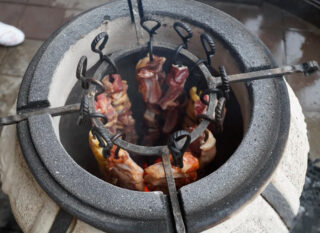
Brick tandoor is a specialized product. Its advantages can only be compared with similar models.
The advantages are as follows.
- Very high efficiency - only 1 portion of fuel is needed to cook 5 portions of kebab in a tandoor. For the barbecue, you will need at least 5 portions of coal or firewood.
- Optimum temperature - the thick walls of the stove wall ensure high heat accumulation. They also guarantee a gradual, uniform heat transfer.
- You can light the tandoor at any time, since the walls are reliably protected from wind or slanting rain.
- Maintenance is minimal: after firing up, clean the walls of soot with a damp cloth and the stove is ready for use.
- When cooking meat and vegetables on skewers, there is no need to turn them over, as the food is evenly fried on all sides.
The disadvantages are significant:
- Firewood and food are loaded through one hole - this is not very hygienic.
- Lack of chimney - smoke is not led out to a safe height. The air flow has to be regulated by the cover.
- To remove the cooked food, you need to use special hooks and wear gloves from the tarp.
The first ignition lasts 3-4 hours or more. The firing later takes less time.
What kind of brick can be used
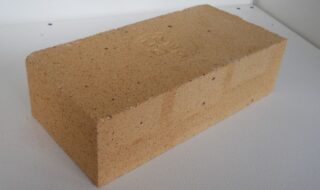
The temperature during the firing of the furnace is quite high and depends on the nature of the fuel. Coal, for example, warms up more strongly than brushwood or dung. Clay is traditionally used for this design, as it can withstand heating up to 1100 ° C.
The dacha tandoor is built only from fireclay bricks using refractory masonry mortar.
Manufacturing technology
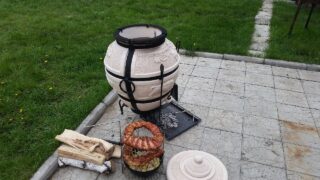
The simplest tandoor is built with their own hands from bricks in any suitable area away from green spaces, wooden buildings, woodpiles and other such objects.
To build a homemade tandoor, you need:
- 150 kg of sand and gravel mixture for the foundation;
- 50-70 pcs. fireclay bricks;
- asbestos fiber - 6 kg;
- refractory masonry mix and paint;
- steel wire from a bar with a diameter of 3 mm;
- mesh mesh with a mesh size of 5 cm.
Of the tools, you need a staple, a container for concrete, as a rule, a trowel. A grinder should be used to cut bricks.
Foundation
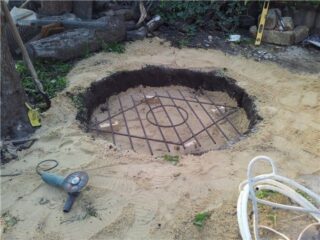
Since a brick tandoor in the country is placed on the street, it is better to make a foundation under it in order to ensure a stable position of the structure. The nature of the foundation depends on the type of soil. On heavy rocky soil, a columnar foundation is made. On heaving soils, choose a slab.
- In the selected area, a hole is dug 10-15 cm in size around the perimeter than the dimensions of the future furnace. The depth of the base is 15–20 cm.
- In the corners of the base, depressions of 70–90 cm are made with a diameter of 12–15 cm.
- The recesses are reinforced and poured with concrete.
- A formwork is erected that rises 15 cm above the ground level. Then a layer of sand 10 cm thick is poured onto the bottom. The sand is poured with water, tamped and leveled.
- For reliability, it is recommended to lay the reinforcement mesh on top of the sand. Then the foundation is poured with concrete.
After the material has dried, but not earlier than 7 days later, the foundation is waterproofed and the laying begins.
Brickwork
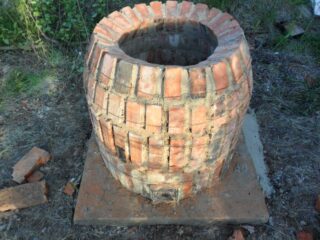
Brick is not a very suitable form for laying out products with rounded or arched walls. This requires a lot of experience. These options are constructed according to a simplified scheme using various step-by-step guides.
Cylinder - the brick is placed vertically, with the side end facing inward. From the inside, such masonry forms a relatively continuous wall, and from the outside it forms gaps. To achieve good heat capacity, the inside of the oven is coated with clay and burned to the state of ceramics.
Edge-laying is not economical. It is better to place the brick with a vertical spoon or poke. However, if the tandoor is built from waste bricks, this option is quite justified.
A more efficient oven is domed or barrel-shaped... To get curved walls from regular parallelepipeds, the latter must be trimmed. It takes a lot of time and experience. A barrel is a complex type of masonry, since it is not at all easy to maintain the required bending radius: you will need special tools and a competent drawing.
Of halves - an economical way of laying. But you need to cut the stone not exactly in the middle, but diagonally. The length of the diagonal and the angle depends on the dimensions of the tandoor and the radius of the bend of the wall.
The brick is laid out in a circle with the narrow side inward. The resulting gaps are filled with clay and fired. If the bricks are cut correctly, the tandoor can be laid very quickly.
Vertical poke and spoons - not so much a way of laying as a more economical method of placing bricks. On spoons - the stone is placed on the edge, the wall is formed by the largest surface of the brick - the bed. In this case, the minimum number of stones is needed to lay out the wall. On a poke - laying a brick on an edge. This is the easiest way to build a barrel-shaped tandoor. First, a wedge of 1–2 cm is cut from the ends of the brick, and then they are tightly joined to each other. The last brick in the row is wedged - cut to the desired shape and forcefully inserted into the row.
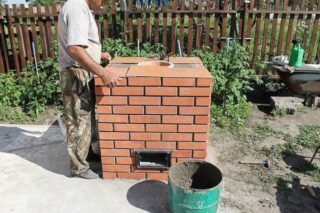
To fold square tandoor made of fireclay bricks much easier. In such a project, a separate hole is provided for loading firewood.
- In rows 1 and 2, a hole is formed for feeding logs. The door is not provided here.
- 3 row solid. A grate is placed here. Half a brick is placed in one of the walls - this hole acts as a blower.
- A blower is formed in the 4th row, in the 5th the hole is closed.
- Starting from level 6, the cross-section of the furnace is reduced, creating a kind of revenue pipe. 5 rows are enough.
- The last row is made wider: this is the protrusion on which the skewer device is later installed.
It is impossible to bake cakes in a square tandoor, however, frying meat, vegetables and fish on skewers will turn out very quickly and easily.
Ring masonry accessories
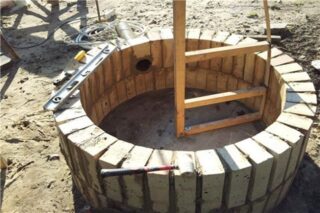
If the oven is laid out "correct" - round, then to maintain the circumference of the walls, special devices are used - templates.
- A cylinder, rolled in galvanized steel or fiberboard, serves as an external template. It can be as high as the future oven, or it can be a narrow "belt". The latter is rearranged upward during laying.
- For the internal template, a semicircular shield is knocked down from the boards using the technique. With its help, the correctness of the circle is checked after laying out each row.
- The internal template can be more complex. First, for him, a metal nail is driven into the center of the bottom of the tandoor, a bar is placed on it, and thin horizontal slats are attached to it with a length equal to the radius of each row - in the center of the brick. The ends of the slats are connected with a strip of wood or steel.
Such a template rotates freely in a circle and allows you to check the correctness of the masonry at any time.
Reinforcement and coating
From the inside, the finished tandoor is coated with clay. It is recommended to burn it well.
Outside, it is also advisable to coat the body with clay. In this case, additional reinforcement is performed. First, a spray is applied to the brick walls, then a soft steel mesh is pressed into it, the next layer of clay is applied and leveled.
Earthen tandoor
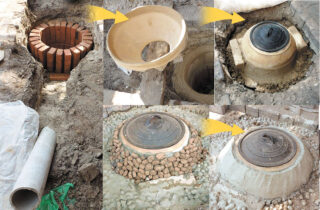
A popular version of the Yamny tandoor. In this case, the walls of the stove are laid out in the ground. This saves on fuel. Moreover, such a model does not need a foundation.
- A hole for the stove is being dug 80 cm wider than the design width of the tandoor. Seals the bottom.
- The furnace is laid out with refractory bricks. You cannot take an ordinary clay one: the oven in the pit cannot be repaired.
- For convenience, the walls of the tandoor are raised above ground level by 15–20 cm.
- The oven is coated from the inside, if necessary, reinforced with steel wire. The latter is sunk into the clay by at least 5 cm.
- The tandoor dries for at least 15 days. Then it is fired for 3–8 hours. If the oven is ready, then the walls emit a ringing sound upon impact.
- Only then can the remaining space between the walls of the furnace and the foundation pit be filled up. They use sand, slag, crushed stone.
The grate is not placed here, firewood and food are fed through the upper hole.
Firing and decoration
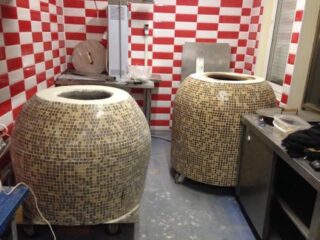
Firing process:
- Hardwood firewood, better than fruit trees, is laid at ¼ of the height of the structure. Burn to coal.
- The next heap is loaded and again burned to coals. The operation is repeated until the charcoal and ash in the stove have occupied up to 2/3 of its volume.
- Close the tandoor and wait until it cools completely.
- Then the oven is cleaned and used for its intended purpose.
They decorate the tandoor, like any other stove: they plaster it, close it up with clinker, red brick, stone, make a mosaic.
Operating rules
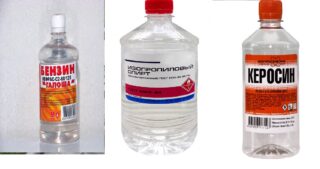
The safety precautions are very simple:
- children and pets are not allowed on the playground during cooking;
- you cannot put a portable tandoor next to wooden objects;
- during cooking, do not touch the walls of the brick model - they are hot;
- you can take out finished products only with tarpaulin gloves and special hooks;
- when firing up, do not bend low.
It is strictly forbidden to use flammable liquids such as alcohol, gasoline, kerosene for ignition.








